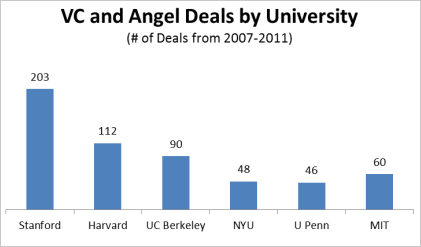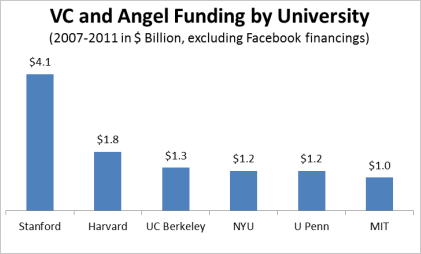Which university has better entrepreneurs?
Some of the most successful companies in recent years have been founded by students of America’s most prestigious universities. The founders of Google and Facebook, from Stanford and Harvard respectively, are prime examples. So which universities have the most successful entrepreneurs? To answer this question, we’ve assessed how many students from each top US university have obtained investment in their startup, how many are worth over $30 million, and how many are worth over $1 billion. This builds upon Jonah Sinick’s work on the wealth of Harvard alumni.
Which university secures more funding?
According to a CB Insights study of deals from 2007-11, Stanford alumni secured 203 venture capital or angel investments, totaling $4.1 billion, more than any other university studied (Figure 1). Harvard came second with 112 deals, totaling $3.8 billion.1 If you exclude Facebook, then Harvard alumni secured $1.8 billion, less than half of Stanford’s total. UC Berkeley, NYU, UPenn and MIT all earned less than $1.4 billion.



Figure 1: VC and Angel Deals by University. From University Entrepreneurship Report by CB Insights.
If we divide the number of deals by the total number of living alumni from each university, we see that Stanford students have been by far the most likely to obtain external funding, followed by MIT.

Figure 2: VC/Angel Deals Per Million Alumni. Using data from University Entrepreneurship Report by CB Insights. Using data on total living alumnus populations from Harvard, UPenn, Stanford, UC Berkeley, NYU and MIT websites.
Which university has most ultra-wealthy individuals?
Another way to assess the entrepreneurial performance of Stanford alumni is to see how many of them are ultra-wealthy. A survey by WealthX in 2013 surveyed ultra-high net worth individuals (UHNWs), defined as individuals worth more than $30 million.
Harvard’s UHNWs had the largest amount of total wealth, $622 billion, amounting to $1.9 million held by the average living alumnus (Table 1). Harvard is followed by MIT, with $1.3 million per alumnus, and UPenn and Stanford, each with 0.8 million per alumnus.
Harvard had the most UHNWs, at 323,000, amounting to an impressive 0.9% of its alumnus population. UPenn, Stanford and MIT follow – about 0.5% of each of their alumni are UHNWs. This does not necessarily that going to Harvard caused entrepreneurial success, and so you cannot necessarily expect such wealth by studying there.
| Population | UHNWs | UHNWs per 100,000 alumni | Total UHNW wealth (US$b) | Total UHNW wealth / total alumni (‘000 US$) | |
| Harvard Alumni | 323,000 | 2964 | 918 | 622 | 1,930 |
| UPenn Alumni | 290,000 | 1502 | 518 | 242 | 830 |
| Stanford Alumni | 215,000 | 1174 | 546 | 171 | 800 |
| MIT Alumni | 129,000 | 581 | 452 | 172 | 1340 |
| Whole USA | 242,000,000 | 65,505 | 27 | 9085 | 38 |
Table 1: The ultra-wealthy at Harvard, UPenn, Stanford, MIT and the whole of the USA. UHNW data from the WealthX UHNW Alumni Rankings Report. Populations of living alumni taken from Harvard, UPenn and Stanford and MIT websites. UHNW: Ultra-high net worth (Greater than $30 million in wealth). UPenn: University of Pennsylvania. US population: the number of citizens over 18 years of age, according to the population in 2013, using demographics from the 2010 census (Census Pop Clock). USA wealth figures are from the WealthX World Ultra Wealth Report.
According to WealthX, this wealth was self-made in 65-75% of cases. This is broadly consistent with our finding that 63% of Stanford billionaires on the Forbes 400 made their own wealth.
Which university has the most billionaires?
We can also check how many billionaires have graduated from each university.
As shown in Table 2, Harvard has the most billionaire wealth, at $200 billion. Relative to its size, MIT has the most billionaire wealth, $800,000 per alumnus, followed by Harvard with $620,000. However, most of MIT’s wealth was held by the Koch brothers, who are in an atypical situation, having inherited significant wealth.2
Harvard has 52 billionaires in total, about double as many as any other university. Billionaires from Harvard are also the most relatively common at 16 per 100,000 alumni, followed by Stanford and MIT with 13 and 12 billionaires per 100,000 respectively.
| Population | Billionaires | Billionaires per 100,000 alumni | Total Billionaire wealth (US$b) | Billionaire wealth / total alumni (’000 US$) | |
| Harvard Alumni | 323,000 | 52 | 16 | 200 | 620 |
| UPenn Alumni | 290,000 | 28 | 10 | 112 | 390 |
| Stanford Alumni | 215,000 | 27 | 13 | 76 | 350 |
| MIT Alumni | 129,000 | 15 | 12 | 114 | 887 |
| Whole USA (23 or older) | 242,000,000 | 515 | 0.20 | 2064 | 8.5 |
Table 2: Likelihood of becoming ultra-wealthy, adjusted for the number of living alumni. From pages 8, 10, 11, 13 of the WealthX UHNW Alumni Rankings Report. UHNW: Ultra-high net worth (Greater than $30 million in wealth). UPenn: University of Pennsylvania. Populations of living alumni taken from Harvard, UPenn, Stanford and MIT websites. Using population estimates from the 2010 census (Census Pop Clock), the US has 260 million citizens over 23 years of age. USA wealth figures are from the WealthX World Ultra Wealth Report.
So as well as having the most UHNWs, Harvard has the most billionaires, and they possess a large amount of wealth relative to the size of their alumnus population. At all of these universities, billionaires are about 50 times more common than in the general population.
Discussion
Students of these universities possess a lot more wealth than the general population. Moreover, students from some universities are much more able to attract funding than others. So did these universities cause the success of their students or did they merely select the students most likely to succeed? This is hard to say, but we can list some plausible causal relationships and some confounding factors.
Two plausible contributors to entrepreneurial success are the reputation and location of these top universities.
Stanford, UC Berkeley and MIT have strong reputations for technical competence, which may help students to successfully attract funding to their startups. Harvard’s prestige may confer a similar advantage.
The universities located in California also have an apparent advantage. In California, a fifth of the largest US tech companies are made.3 This should inspire students to become entrepreneurs, increasing the availability of cofounders. In the Southern parts of California (up to Silicon Valley), a third of US venture capital deals are made,4 giving Stanford and UC Berkeley students a distinct advantage in obtaining funding. If this is true, one might wonder why UC Berkeley performed so much worse than Harvard and MIT (Figure 2). The obvious explanation for this is that it is a public university. In fact, its students are the second wealthiest of all public universities. The fact that UC Berkeley students attracted more funding than those from UPenn and NYU merits an explanation, and the most obvious one is geography.5
Confounding factors include academic performance, wealth and demographics.
Stanford and Harvard have the highest entrance scores in the US.6 The students from these universities are also unusually wealthy. This is a significant confounding variable – these students would be more likely to succeed wherever they studied. However, this clustering may also play a causal role. On one interpretation, top universities gather cofounders and investors, causing them to be more likely to succeed. We regard these two accounts as plausible and mutually compatible.
Two additional factors confound the high-net worth statistics. First, these figures include wealth earned outside of entrepreneurship, such as by inheritance or finance. Second, they are confounded by the age of the alumni because wealth tends to increase with age. One reason for Harvard’s superior billionaire count may be their higher average age. This is suggested by the fact that Harvard has 6.5% as many students as alumni, compared to Stanford’s 7.4%.7
Also, some business classes may perform so well that they make their entire university look good. Examples of this are the MBA programs of Stanford and Harvard, which educated Steve Ballmer and Michael Bloomberg, respectively. This effect may merit further investigation.
Overall, we’re uncertain to what extent attending one of these universities contributes to success or merely correlates with it, though we expect there are some beneficial effects.
Conclusion
Stanford and Harvard have the most successful entrepreneurs among their alumni. Harvard’s alumni are wealthier, while Stanford founders get more funding.
Footnotes
- University Entrepreneurship Report. by CB Insights. ↩
- “Under Charles’s leadership, the company extended its interests into areas far beyond petroleum and increased its annual revenue 250-fold in 40 years, to an estimated $100 billion in 2009.” Charles G. and Davig H. Koch, Encyclopaedia Britannica ↩
- “The United States averages twenty technology companies founded per year that reach $100 million in revenues Approximately four of those companies are usually in California.”, report the Kauffman Foundation in The Constant – Companies That Matter ↩
- In 2013, 1272 deals were made in Silicon Valley of 4077 across the US (31%), from the MoneyTree by PriceWaterhouseCoopers ↩
- p22, WealthX UHNW Alumni Rankings Report ↩
- Top 15 univeristies and their average SAT scores ↩
- Harvard has 21,000 current students and 323,000 living alumni whereas Stanford has 16,000 students and 215,000 living alumni. ↩